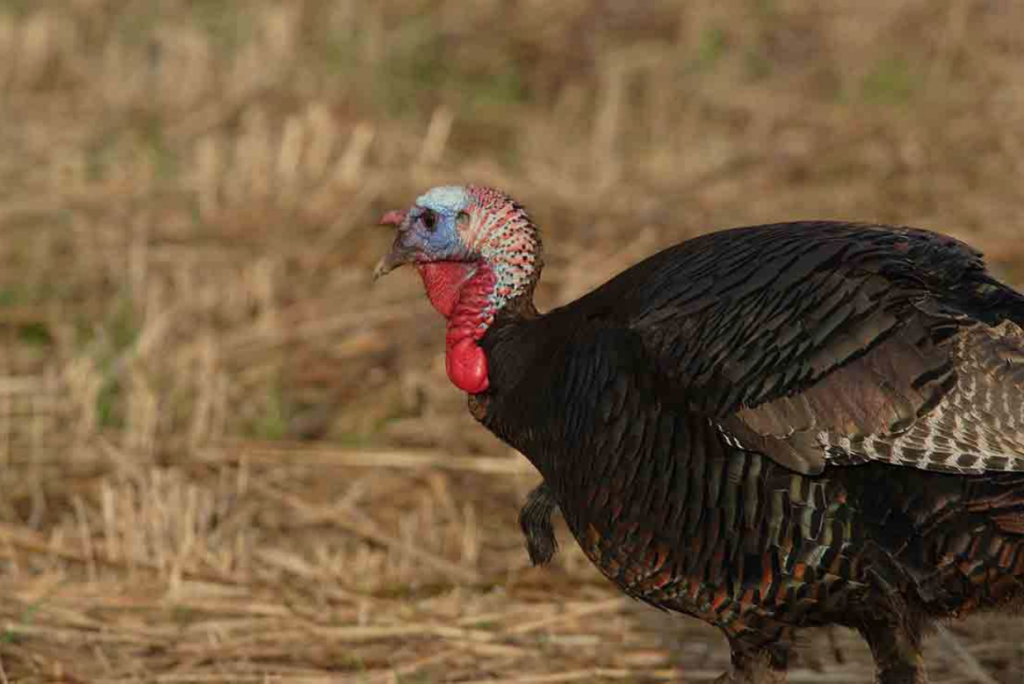
Young gobblers begin to establish their dominance and older ones help them learn the pecking order during the critical autumn season.
Wild turkey flocks change in autumn in a variety of ways, including jakes starting to establish dominance and learning the pecking order. It’s just part of the natural cycle of things. Hunters interested in learning more about autumn turkey hunting strategies and biology can do so during this important time of the year.
This is the first of two parts from the Fall & Winter Turkey Hunter’s Handbook by Steve Hickoff:
Wild turkeys hatch throughout the spring and summer, depending on when the hen bred, and successfully nested. Since hatching times are varied, some autumn family groups contain young birds (especially males) the size of the adult brood hen. Other such fall flocks might have a recognizable female turkey leading birds-of-the-year that are considerably smaller. Biology tells us a typical clutch is eight to twelve eggs. A single family flock of a dozen birds is large. Predators take their fill.
A brood hen with just a single young bird or just several more can be occasionally seen due to predation, or weather factors, while big groups of several juvenile flocks and brood hens can be noted as well. These family flocks stay together until juvenile males leave to form their own jake groups in late fall. As mentioned, later in the autumn season, young gobblers tend to dominate flocks even more than adult hens, creating obvious disharmony. By then, they move on to form jake-only flocks. Sometimes these small male groups meet up with other gobblers in the area too.

Juvenile birds encounter a variety of predatory attacks and other problems. Photo: Bill Buchanan/ USFWS
JUVENILE FLOCKS WITHOUT BROOD HENS
Fall turkey hunters sometimes wonder whether it’s okay to legally take a brood hen from a family flock. I’ve put this question to biologists, and they generally agree that the flock’s survival chances are good, as young birds grow wary over summer and into autumn. They have to. As a prey species, turkeys have it tough on a daily basis — young and adult alike. Late hatch flocks, those with pheasant-sized juveniles as hunting seasons begin, likely have more of a challenge, what with less experience in the wild.
This past late summer, through fall and into late winter, I watched a flock of nine juvenile turkeys without a brood hen. They had chosen a roughly five-acre area (split by the busy interstate highway) for their home ground, and roosted there. I’d see them on an almost daily basis, hugging the edge cover, and silently feeding on available foods. Why they were without a brood hen is anyone’s guess (roadkill?), but I watched through the months as the gobblers — four all told — grew to be easily distinguished from the smaller hens in the flock: red heads, black-tipped breast feathers, and sprouting beards told the story.
All winter they remained, disturbed only briefly by gawking motorists like myself, whereupon they would vanish into thicker, albeit limited, wooded cover. I never once heard any calling from that spot, and assume they got together daily on a purely visual basis. Some days I wouldn’t see them at all, just their tracks crossing the snowy on-ramp. Days later they’d be back. At one point in late winter, a young hen turned up dead along the major highway, having wandered out of the tight habitat.
As spring approached, I noted that all four young gobblers were suddenly gone from the group in their wanderlust mode. Not long after, a strutting mature longbeard had moved into the small area, and collected the remaining four hens for his effort. I never heard a gobble from him either, though I would listen for it at daybreak. Shortly after that, all of the turkeys were gone–all this several weeks before the spring hunting season opened.
Can a family flock survive without their brood hen? In this case, noting the loss of the single young hen, yes. Do turkeys go silent in a challenging situation when getting together visually makes calling unnecessary? In this case, maybe.
JAKE-ONLY FLOCKS
Fall jakes born that year become dominant before they leave the family flock in late autumn or winter, challenging the brood hen’s status. A single dominant jake will sometimes even call family flock members back together after the morning fly-down or after a predator (or hunter) flushes them. Flock harmony is disrupted for a time. While in the family group, and after they leave it, male turkeys routinely fight to establish pecking order.
In jake-only flocks, a dominant bird usually rules this entire group–until status is contested. This is why some of us have shot a gobbler, only to see other male birds move right in to peck at, claw, and mock breed the dead turkey. The survivors want top-dog status. As fall and winter progresses, these jakes will often join one or more adult gobblers. One bird in that group–often a longbeard — will hold spring breeding rights to all the hens in the area; that is, unless its position is challenged. Nevertheless, it’s also not uncommon to see a band of jakes defeat an adult gobbler in a fight. I’ve watched gangs of juvenile turkeys run off longbeards, and vice-versa.
YEAR-AND-A-HALF-OLD GOBBLERS
Called “jake-and-a-halfs” or “super jakes” by us turkey hunters, these male birds are roughly sixteen to eighteen months old when autumn arrives, depending on geographical location.
Distinguished from male birds under a year old, their beards are five to eight inches long. Their spurs are still less than an inch. Their tail fans are full. They run together in small groups, often the same birds they spent time with that past spring. They can appear identical, which suggests they were from the same brood. They work well to the autumn hunter’s call, often gobbling and even strutting, and provide a lot of enjoyment during the fall hunt. Their weight in your vest’s game pocket is substantial.
Remember, this is the same bird you passed on in spring because he had a beard resembling a stubbed-out cigar. Some autumn hunters will kill a super jake, and refer to it as a longbeard. That’s fine. Technically it is, I guess, but a wild gobbler that’s been alive for two years or more is often an entirely different creature.
Editor’s Note: The following article is an excerpt from Steve Hickoff’s book, Fall & Winter Turkey Hunter’s Handbook. For more information visit hickoff.blogspot.com/.

